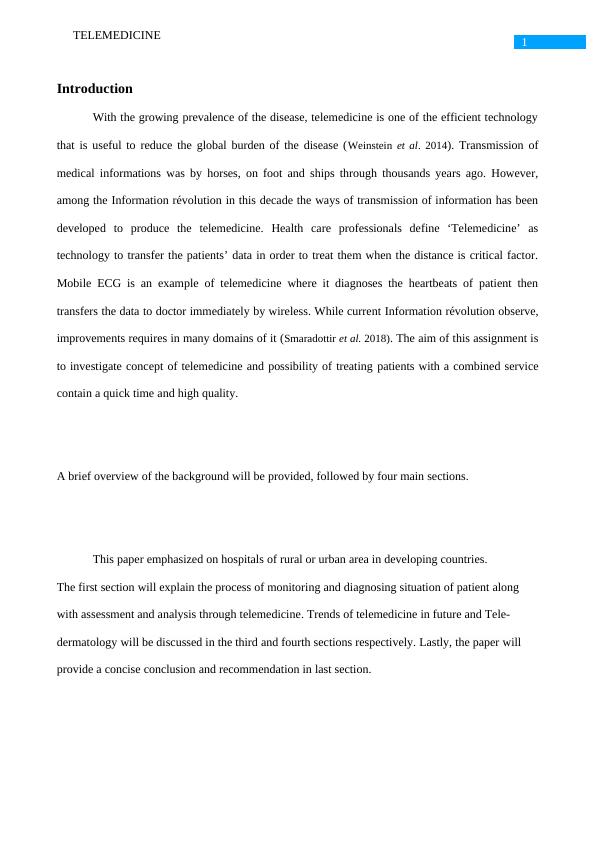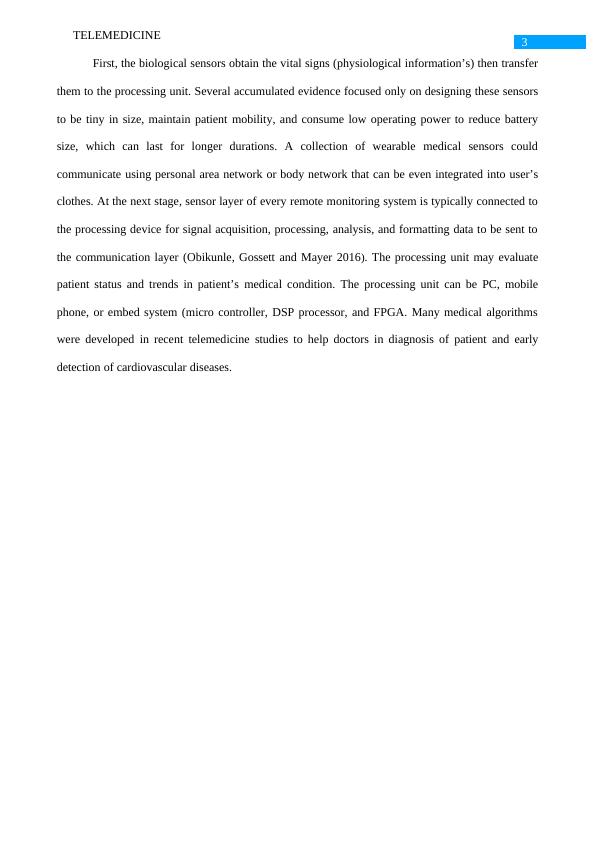Assignment on Telemedicine PDF
13 Pages2781 Words61 Views
Added on 2021-12-21
Assignment on Telemedicine PDF
Added on 2021-12-21
ShareRelated Documents
Running head: TELEMEDICINE
Telemedicine
Name of the Student
Name of the University
Author note
Telemedicine
Name of the Student
Name of the University
Author note

1
TELEMEDICINE
Introduction
With the growing prevalence of the disease, telemedicine is one of the efficient technology
that is useful to reduce the global burden of the disease (Weinstein et al. 2014). Transmission of
medical informations was by horses, on foot and ships through thousands years ago. However,
among the Information révolution in this decade the ways of transmission of information has been
developed to produce the telemedicine. Health care professionals define ‘Telemedicine’ as
technology to transfer the patients’ data in order to treat them when the distance is critical factor.
Mobile ECG is an example of telemedicine where it diagnoses the heartbeats of patient then
transfers the data to doctor immediately by wireless. While current Information révolution observe,
improvements requires in many domains of it (Smaradottir et al. 2018). The aim of this assignment is
to investigate concept of telemedicine and possibility of treating patients with a combined service
contain a quick time and high quality.
A brief overview of the background will be provided, followed by four main sections.
This paper emphasized on hospitals of rural or urban area in developing countries.
The first section will explain the process of monitoring and diagnosing situation of patient along
with assessment and analysis through telemedicine. Trends of telemedicine in future and Tele-
dermatology will be discussed in the third and fourth sections respectively. Lastly, the paper will
provide a concise conclusion and recommendation in last section.
TELEMEDICINE
Introduction
With the growing prevalence of the disease, telemedicine is one of the efficient technology
that is useful to reduce the global burden of the disease (Weinstein et al. 2014). Transmission of
medical informations was by horses, on foot and ships through thousands years ago. However,
among the Information révolution in this decade the ways of transmission of information has been
developed to produce the telemedicine. Health care professionals define ‘Telemedicine’ as
technology to transfer the patients’ data in order to treat them when the distance is critical factor.
Mobile ECG is an example of telemedicine where it diagnoses the heartbeats of patient then
transfers the data to doctor immediately by wireless. While current Information révolution observe,
improvements requires in many domains of it (Smaradottir et al. 2018). The aim of this assignment is
to investigate concept of telemedicine and possibility of treating patients with a combined service
contain a quick time and high quality.
A brief overview of the background will be provided, followed by four main sections.
This paper emphasized on hospitals of rural or urban area in developing countries.
The first section will explain the process of monitoring and diagnosing situation of patient along
with assessment and analysis through telemedicine. Trends of telemedicine in future and Tele-
dermatology will be discussed in the third and fourth sections respectively. Lastly, the paper will
provide a concise conclusion and recommendation in last section.

2
TELEMEDICINE
Discussion:
Assessment and analysis of patient’s situation through telemedicine:
Among last a few years, remote healthcare systems started acknowledging the importance
of the tele-medicine. Therefore, evaluation and collection of vital signs continuously are basic
criteria in these cases. In order to evaluate vital signs, long-term healthcare and 3G connecting to
hospitals is crucial internet network that will deliver both data and information. Some physiological
signs are received by this system such as Electro Cardio Gram ECG, degree of body temperature,
SpO2 and blood pressure and transfer them to smart data analysis in order to diagnose and explore
chronic diseases (Panlaquiv et al. 2017). Easy interface among internet for professional health team
is available to take note of signal pulses for remote treatment. In case of an unusual event, all
physiological signs will be transferred directly to far health server by internet or cellular network or
both of them. By GPRS data able to transferred to mobile phone of the doctor or parents (Kahn et
al. 2018). A prototype of such system has been successfully developed and implemented, which
will offer high standard of healthcare with a major reduction in cost for our society.
HTTP: HyperText Transfer Protocol
GPRS: General Packet Radio Services
SpO2: stands for peripheral capillary oxygen saturation
ECG: electrocardiogram
TCP/IP: Transmission Control Protocol/Internet Protocol
PDA:
TELEMEDICINE
Discussion:
Assessment and analysis of patient’s situation through telemedicine:
Among last a few years, remote healthcare systems started acknowledging the importance
of the tele-medicine. Therefore, evaluation and collection of vital signs continuously are basic
criteria in these cases. In order to evaluate vital signs, long-term healthcare and 3G connecting to
hospitals is crucial internet network that will deliver both data and information. Some physiological
signs are received by this system such as Electro Cardio Gram ECG, degree of body temperature,
SpO2 and blood pressure and transfer them to smart data analysis in order to diagnose and explore
chronic diseases (Panlaquiv et al. 2017). Easy interface among internet for professional health team
is available to take note of signal pulses for remote treatment. In case of an unusual event, all
physiological signs will be transferred directly to far health server by internet or cellular network or
both of them. By GPRS data able to transferred to mobile phone of the doctor or parents (Kahn et
al. 2018). A prototype of such system has been successfully developed and implemented, which
will offer high standard of healthcare with a major reduction in cost for our society.
HTTP: HyperText Transfer Protocol
GPRS: General Packet Radio Services
SpO2: stands for peripheral capillary oxygen saturation
ECG: electrocardiogram
TCP/IP: Transmission Control Protocol/Internet Protocol
PDA:

3
TELEMEDICINE
First, the biological sensors obtain the vital signs (physiological information’s) then transfer
them to the processing unit. Several accumulated evidence focused only on designing these sensors
to be tiny in size, maintain patient mobility, and consume low operating power to reduce battery
size, which can last for longer durations. A collection of wearable medical sensors could
communicate using personal area network or body network that can be even integrated into user’s
clothes. At the next stage, sensor layer of every remote monitoring system is typically connected to
the processing device for signal acquisition, processing, analysis, and formatting data to be sent to
the communication layer (Obikunle, Gossett and Mayer 2016). The processing unit may evaluate
patient status and trends in patient’s medical condition. The processing unit can be PC, mobile
phone, or embed system (micro controller, DSP processor, and FPGA. Many medical algorithms
were developed in recent telemedicine studies to help doctors in diagnosis of patient and early
detection of cardiovascular diseases.
TELEMEDICINE
First, the biological sensors obtain the vital signs (physiological information’s) then transfer
them to the processing unit. Several accumulated evidence focused only on designing these sensors
to be tiny in size, maintain patient mobility, and consume low operating power to reduce battery
size, which can last for longer durations. A collection of wearable medical sensors could
communicate using personal area network or body network that can be even integrated into user’s
clothes. At the next stage, sensor layer of every remote monitoring system is typically connected to
the processing device for signal acquisition, processing, analysis, and formatting data to be sent to
the communication layer (Obikunle, Gossett and Mayer 2016). The processing unit may evaluate
patient status and trends in patient’s medical condition. The processing unit can be PC, mobile
phone, or embed system (micro controller, DSP processor, and FPGA. Many medical algorithms
were developed in recent telemedicine studies to help doctors in diagnosis of patient and early
detection of cardiovascular diseases.

End of preview
Want to access all the pages? Upload your documents or become a member.
Related Documents
Telemedicine and Healthcare Technology Trendslg...
|4
|712
|446
IoT in Telemedicine: Supporting Healthcare Delivery through Technologylg...
|14
|3428
|377
A Cloud Computing Solution for Data Collection of Patients in Healthcarelg...
|12
|2929
|300
IoT in Healthcare: Literature Review and Discussionslg...
|9
|1974
|315
ITC 560 - Internet of Thingslg...
|7
|1333
|157
Health Care in the Digital Worldlg...
|11
|765
|44
